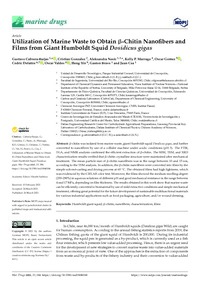Utilization of marine waste to obtain β-chitin nanofibers and films from giant Humboldt squid dosidicus gigas
Autor
Cabrera-Barjas, Gustavo
González, Cristian
Nesic, Aleksandra
Marrugo, Kelly P.
Gómez, Oscar
Delattre, Cédric
Valdés-Lizama, Oscar
Yin, Heng
Bravo, Gaston
Cea, Juan
Fecha
2021Resumen
β-chitin was isolated from marine waste, giant Humboldt squid Dosidicus gigas, and further converted to nanofibers by use of a collider machine under acidic conditions (pH 3). The FTIR, TGA, and NMR analysis confirmed the efficient extraction of β-chitin. The SEM, TEM, and XRD characterization results verified that β-chitin crystalline structure were maintained after mechanical treatment. The mean particle size of β-chitin nanofibers was in the range between 10 and 15 nm, according to the TEM analysis. In addition, the β-chitin nanofibers were converted into films by the simple solvent-casting and drying process at 60 °C. The obtained films had high lightness, which was evidenced by the CIELAB color test. Moreover, the films showed the medium swelling degree (250–290%) in aqueous solutions of different pH and good mechanical resistance in the range between 4 and 17 MPa, depending on film thickness. The results obtained in this work show that marine waste can be efficiently converted to biomaterial by use of mild extractive conditions and simple mechanical treatment, offering great potential for the future development of sustainable multifunctional materials for various industrial applications such as food packaging, agriculture, and/or wound dressing.
Fuente
Marine Drugs, 19(4), 184Link de Acceso
Click aquí para ver el documentoIdentificador DOI
doi.org/10.3390/md19040184Colecciones
La publicación tiene asociados los siguientes ficheros de licencia:


